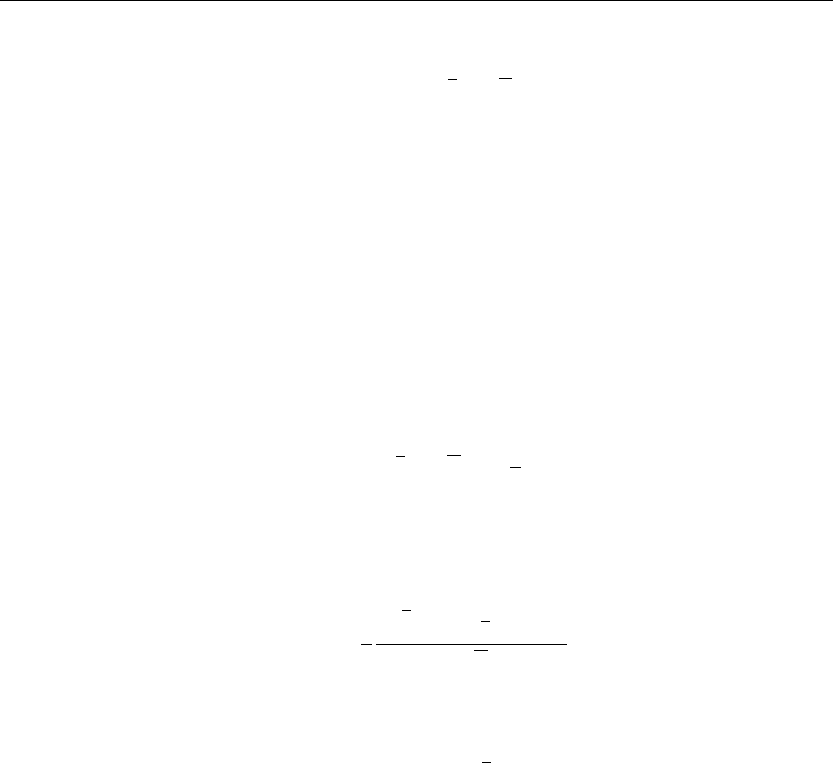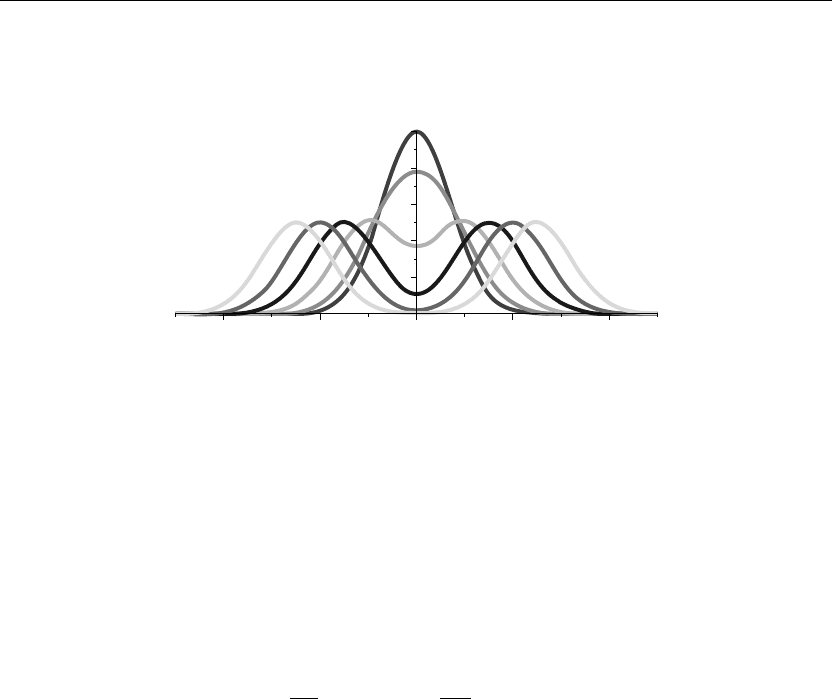Articolo G.A. Partial Differential Equations and Boundary Value Problems with Maple V
Подождите немного. Документ загружается.


588 Chapter 9
nonhomogeneous differential equation in the time variable t:
∂
2
∂t
2
U(ω, t) +c
2
ω
2
U(ω, t) = H(ω, t)
with the two initial conditions
U(ω, 0) =
∞
−∞
f(x) e
−iωx
dx
and
V(ω, 0) =
∞
−∞
g(x) e
−iωx
dx
This is a second-order initial value problem and, from Chapter 1, Section 1.8, the solution to
the preceding differential equation is
U(ω, t) = U(ω, 0) cos(ωct) +
V(ω, 0) sin(ωct)
ωc
+
t
0
H(ω, τ) sin(ωc(t −τ))
ωc
dτ
Thus, from the preceding transform, the solution to our nonhomogeneous partial differential
equation can be written as the Fourier integral
u(x, t) =
∞
−∞
U(ω, t) e
iωx
2π
dω
where U(ω, t) is the solution to the preceding time equation.
9.9 Wave Equation over Semi-infinite Domains
We now consider the same problem as in the preceding section, but for a semi-infinite interval
I ={x |0 <x<∞}. We continue to assume that all functions are piecewise smooth and
absolutely integrable with respect to x over the semi-infinite interval. Depending on the
boundary condition at x = 0, we will utilize those singular eigenfunctions that are consistent
with the boundary condition.
If at x = 0 we have the type 1 condition
u(0,t)= 0

Infinite and Semi-infinite Spatial Domains 589
then the appropriate singular orthonormalized eigenfunctions, from Section 9.3, are given as
√
2 sin(ωx)
√
π
for 0 <ω<∞. Thus, we can write our solution in terms of the singular eigenfunctions as
u(x, t) =
∞
0
2U(ω, t) sin(ωx)
π
dω
From Section 9.3, U(ω, t) is the time-dependent Fourier sine transform of u(x, t).Ifwe
substitute the initial conditions into this solution, we get
f(x) =
∞
0
2U(ω, 0) sin(ωx)
π
dω
and
g(x) =
∞
0
2V(ω, 0) sin(ωx)
π
dω
Here, U(ω, 0) is the Fourier sine transform of the initial condition function f(x), and V(ω, 0) is
the Fourier sine transform of the initial speed function g(x); that is,
U(ω, 0) =
∞
0
f(x) sin(ωx) dx
and
V(ω, 0) =
∞
0
g(x) sin(ωx) dx
In a similar manner, the source term h(x, t) can be expressed as the Fourier sine integral
h(x, t) =
∞
0
2H(ω, t) sin(ωx)
π
dω
where H(ω, t) is now the Fourier sine transform of h(x, t); that is,
H(ω, t) =
∞
0
h(x, t) sin(ωx) dx

590 Chapter 9
Proceeding formally as we did earlier, the solution for U(ω, t) is
U(ω, t) = U(ω, 0) cos(ωct) +
V(ω, 0) sin(ωct)
ωc
+
t
0
H(ω, τ) sin(ωc(t −τ))
ωc
dτ
Thus, the final solution to our nonhomogeneous wave partial differential equation over the
semi-infinite interval, with type 1 conditions at the origin, can be written as the Fourier sine
integral
u(x, t) =
∞
0
2U(ω, t) sin(ωx) dω
π
where U(ω, t) was given above.
On the other hand, if, at x = 0, we have the type 2 condition
u
x
(0,t)= 0
then the appropriate singular orthonormalized eigenfunctions, from Section 9.3, are given as
√
2 cos(ωx)
√
π
for 0 <ω<∞.
Thus, we can write our solution in terms of the singular eigenfunctions as
u(x, t) =
∞
0
2U(ω, t) cos(ωx)
π
dω
From Section 9.3, U(ω, t) is the time-dependent Fourier cosine transform of u(x, t).Ifwe
substitute the two initial conditions on this solution, we get
f(x) =
∞
0
2U(ω, 0) cos(ωx)
π
dω
and
g(x) =
∞
0
2V(ω, 0) cos(ωx)
π
dω

Infinite and Semi-infinite Spatial Domains 591
Here, U(ω, 0) is the Fourier cosine transform of the initial condition function f(x), and V(ω, 0)
is the Fourier cosine transform of the initial speed function g(x); that is,
U(ω, 0) =
∞
0
f(x) cos(ωx) dx
and
V(ω, 0) =
∞
0
g(x) cos(ωx) dx
In a similar manner, the source term h(x, t) can be expressed as the Fourier cosine integral
h(x, t) =
∞
0
2H(ω, t) cos(ωx)
π
dω
where H(ω, t) is now the Fourier cosine transform of h(x, t); that is,
H(ω, t) =
∞
0
h(x, t) cos(ωx) dx
Proceeding formally as we did earlier, the solution for U(ω, t) is again
U(ω, t) = U(ω, 0) cos(ωct) +
V(ω, 0) sin(ωct)
ωc
+
t
0
H(ω, τ) sin(ωc(t −τ))
ωc
dτ
Thus, the final solution to our nonhomogeneous wave partial differential equation over the
semi-infinite interval, with type 2 boundary conditions at the origin, can be written as the
Fourier cosine integral
u(x, t) =
∞
0
2U(ω, t) cos(ωx)
π
dω
where U(ω, t) was given above.
Similar to the case for diffusion problems, the method of images can also be used for the wave
equation problems over semi-infinite domains. We now demonstrate this concept by solving an
illustrative problem.
DEMONSTRATION: We seek the wave amplitude u(x, t) for transverse waves on a long
string over the semi-infinite interval I ={x |0 <x<∞}, which is unsecured at x = 0.

592 Chapter 9
The initial displacement of the string u(x, 0) = f(x) is given as follows, and the initial speed
distribution u
t
(x, 0) = g(x) has the value 0. There are no external forces acting on the string,
and the wave speed is c = 1/2.
SOLUTION: For transverse waves on a string, the homogeneous wave partial differential
equation is
∂
2
∂t
2
u(x, t) =
∂
2
∂x
2
u(x, t)
4
Because the string is unsecured at the end point x = 0 and we require the solution to be
absolutely integrable over the semi-infinite inteval I, the system boundary conditions are
u
x
(0,t)= 0 and
∞
0
|u(x, t)|dx<∞
The initial displacement function of the string is given as u(x, 0) = f(x) where
f(x) = e
−x
2
and the initial speed distribution is given as u
t
(x, 0) = g(x) where
g(x) = 0
We can solve this problem by using either the method of the Fourier cosine transform, as
discussed earlier, or we can use the equivalent method of images. We choose the method of
images here.
Using the Heaviside function, we establish the even extension fe(x) of the initial displacement
distribution f(x) by reflecting it about the y-axis as follows:
fe(x) = e
−x
2
H(x) +e
−x
2
H(−x)
and the even extension of the initial speed distribution is
ge(x) = 0
With the even extensions of the initial displacement and speed distributions defined over the
infinite interval I ={x |−∞<x<∞}, we can now use the method of the Fourier integral and
write the solution as
u(x, t) =
∞
−∞
U(ω, t) e
iωx
2π
dω

Infinite and Semi-infinite Spatial Domains 593
Substitution of this solution into the partial differential equation, as we did in Section 9.8,
yields the time-dependent ordinary differential equation
∂
2
∂t
2
U(ω, t) +
ω
2
U(ω, t)
4
= 0
We must now solve this differential equation subject to the given initial conditions. Evaluation
of the transform of the initial displacement function fe(x) (note the function in this case is
already even) yields
U(ω, 0) =
∞
−∞
e
−x
2
e
−iωx
dx
which is evaluated to be
U(ω, 0) =
√
πe
−
ω
2
4
Similarly, evaluation of the transform of the initial speed distribution ge(x) yields
V(ω, 0) = 0
Thus, from Section 9.8, the solution to the time-dependent differential equation for the Fourier
transform U(ω, t), subject to the two initial conditions, is
U(ω, t) =
√
πe
−
ω
2
4
cos
ωt
2
Finally, from this known transform, the Fourier integral form of the solution is given as
u(x, t) =
∞
−∞
e
−
ω
2
4
cos
ωt
2
2
√
π
dω
Evaluation of this integral yields the solution for the string displacement
u(x, t) =
e
−2xt
+1
e
−
(2x−t)
2
4
2
for x>0.
The details for the solution of this problem along with the graphics are given later in one of the
Maple worksheet examples.

594 Chapter 9
9.10 Example Wave Equation Problems over Infinite and
Semi-infinite Domains
We now consider solutions to some wave equation problems over infinite and semi-infinite
domains. We use the procedures from the preceding section to develop our solutions.
EXAMPLE 9.10.1: (Waves on an infinite string) We seek the wave amplitude u(x, t) for
transverse wave motion on a long string over the infinite interval I ={x |−∞<x<∞},
which has an initial displacement u(x, 0) = f(x) given as follows. The initial speed distribution
u
t
(x, 0) = g(x) is 0, there are no external forces acting on the system, and the wave speed is
c = 1/2.
SOLUTION: The wave partial differential equation is
∂
2
∂t
2
u(x, t) = c
2
∂
2
∂x
2
u(x, t)
The boundary condition is that the solution be absolutely integrable over the interval; that is,
∞
−∞
|u(x, t)|dx<∞
The initial conditions are
u(x, 0) = e
−x
2
and u
t
(x, 0) = 0
The Fourier integral form of the solution is
u(x, t) =
∞
−∞
U(ω, t) e
iωx
2π
dω
Here, U(ω, t) satisfies the differential equation
∂
2
∂t
2
U(ω, t) +c
2
ω
2
U(ω, t) = 0
Assignment of system parameters
> restart:with(inttrans):with(plots):c:=1/2:f(x):=exp(−xˆ2):g(x):=0:
Fourier transform of initial conditions
> U(omega,0):=Int(f(x)*exp(−I*omega*x),x=−infinity..infinity);U(omega,0):=value(%):
U(ω, 0) :=
∞
−∞
e
−x
2
e
−Iωx
dx (9.34)

Infinite and Semi-infinite Spatial Domains 595
> U(omega,0):=simplify(value(%));
U(ω, 0) := e
−
1
4
ω
2
√
π (9.35)
> V(omega,0):=Int(g(x)*exp(−I*omega*x),x=−infinity..infinity);V(omega,0):=value(%):
V(ω, 0) :=
∞
−∞
0dx (9.36)
> V(omega,0):=simplify(value(%));
V(ω, 0) := 0 (9.37)
Fourier transform of solution
> U(omega,t):=U(omega,0)*cos(omega*c*t)+V(omega,0)*sin(omega*c*t)/(omega*c);
U(ω, t) := e
−
1
4
ω
2
√
π cos
1
2
ωt
(9.38)
Fourier integral solution
> u(x,t):=Int(U(omega,t)/(2*Pi)*exp(I*omega*x),omega=−infinity..infinity);
u(x, t) :=
∞
−∞
1
2
e
−
1
4
ω
2
cos
1
2
ωt
e
Iωx
√
π
dω (9.39)
> u(x,t):=invfourier(U(omega,t),omega,x);
u(x, t) := cosh(tx)e
−
1
4
t
2
−x
2
(9.40)
ANIMATION
> animate(u(x,t),x=−5..5,t=0..5,thickness=3);
The preceding animation command shows the spatial-time-dependent solution of the wave
amplitude u(x, t). The animation sequence here and in Figure 9.5 shows snapshots of the
animation at times t = 0, 1, 2, 3, 4, 5.
ANIMATION SEQUENCE
> u(x,0):=subs(t=0,u(x,t)):u(x,1):=subs(t=1,u(x,t)):
> u(x,2):=subs(t=2,u(x,t)):u(x,3):=subs(t=3,u(x,t)):

596 Chapter 9
> u(x,4):=subs(t=4,u(x,t)):u(x,5):=subs(t=5,u(x,t)):
> plot({u(x,0),u(x,1),u(x,2),u(x,3),u(x,4),u(x,5)},x=−5..5,thickness=10);
0
x
0.2
0.4
0.6
0.8
1
242224
Figure 9.5
EXAMPLE 9.10.2: (Solution by method of images) We seek the wave amplitude u(x, t) for
transverse waves over a long string over the semi-infinite interval I ={x |0 <x<∞}. The end
x = 0 is held fixed. The initial displacement distribution u(x, 0) = f(x) is given as follows, and
the initial speed distribution u
t
(x, 0) = g(x) is 0. There are no external forces acting on the
system, and the wave speed is c = 1/2. We solve this problem using the method of images by
forming the odd extension of f(x) and using the regular Fourier integral.
SOLUTION: The wave partial differential equation is
∂
2
∂t
2
u(x, t) = c
2
∂
2
∂x
2
u(x, t)
The boundary conditions are that the solution be absolutely integrable over the interval and we
have a type 1 condition at x = 0:
∞
0
|u(x, t)|dx<∞ and u(0,t)= 0
The initial conditions are
u(x, 0) = xe
−x
2
and u
t
(x, 0) = 0
By the method of images, we use the Heaviside function H(x) to form the odd extension fo(x)
of f(x) with the operation
fo(x) = f(x)H(x) −f(−x)H(−x)

Infinite and Semi-infinite Spatial Domains 597
The Fourier integral form of the solution is
u(x, t) =
∞
−∞
U(ω, t) e
iωx
2π
dω
Here, U(ω, t) satisfies the differential equation
∂
2
∂t
2
U(ω, t) +c
2
ω
2
U(ω, t) = 0
Assignment of system parameters
> restart:with(inttrans):with(plots):c:=1/2:f(x):=x*exp(−xˆ2):f(−x):=subs(x=−x,f(x)):g(x):=0:
g(−x):=subs(x=−x,g(x)):
Formation of the odd extension of f(x) and g(x)
> fo(x):=f(x)*Heaviside(x)−f(−x)*Heaviside(−x);
fo(x) := x e
−x
2
Heaviside(x) +x e
−x
2
Heaviside(−x) (9.41)
> go(x):=g(x)*Heaviside(x)−g(−x)*Heaviside(−x);
go(x) := 0 (9.42)
Fourier transform of initial conditions
> U(omega,0):=Int(fo(x)*exp(−I*omega*x),x=−infinity..infinity);
U(ω, 0) :=
∞
−∞
x e
−x
2
Heaviside(x) +x e
−x
2
Heaviside(−x)
e
−Iωx
dx (9.43)
> U(omega,0):=expand(fourier(f(x),x,omega));
U(ω, 0) := −
1
2
Iω e
−
1
4
ω
2
√
π (9.44)
> V(omega,0):=Int(go(x)*exp(−I*omega*x),x=−infinity..infinity);V(omega,0):=value(%):
V(ω, 0) :=
∞
−∞
0dx (9.45)
> V(omega,0):=simplify(value(%));
V(ω, 0) := 0 (9.46)
